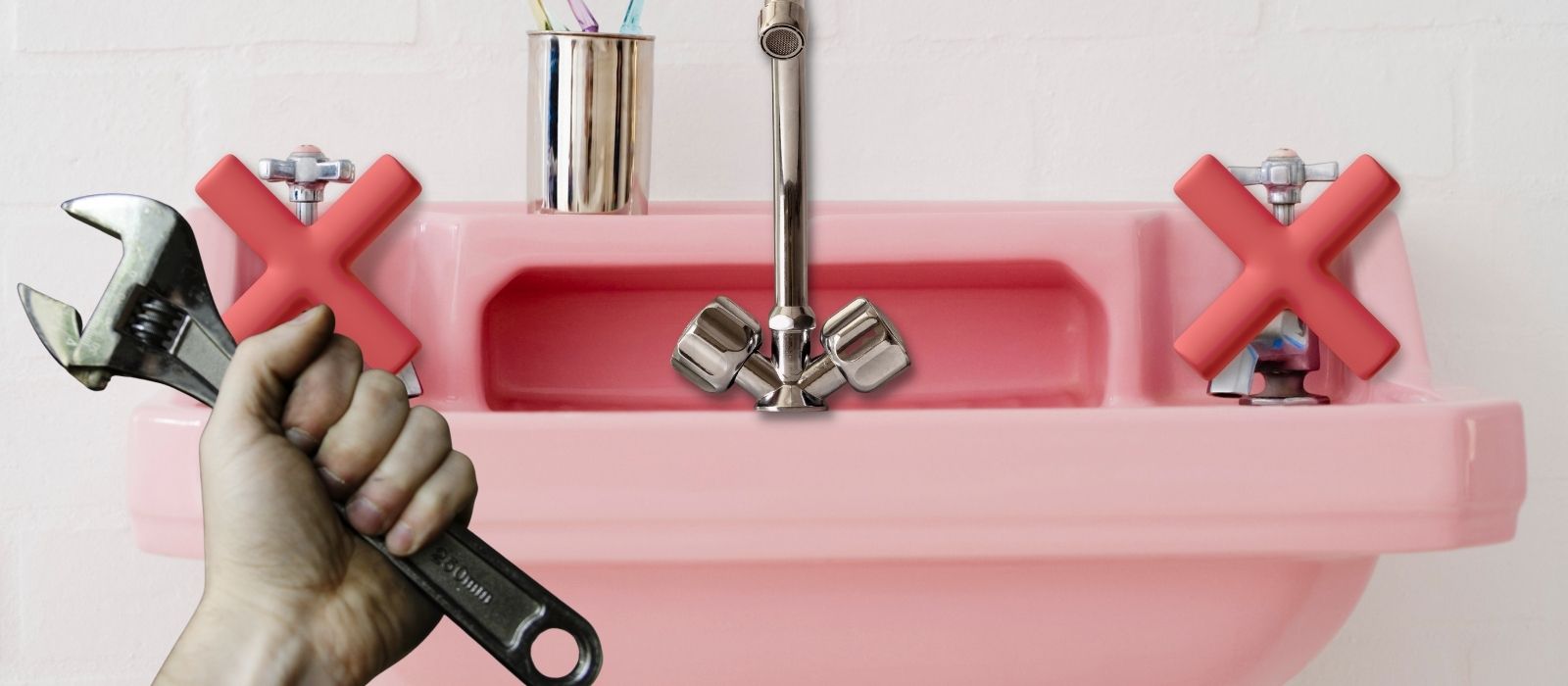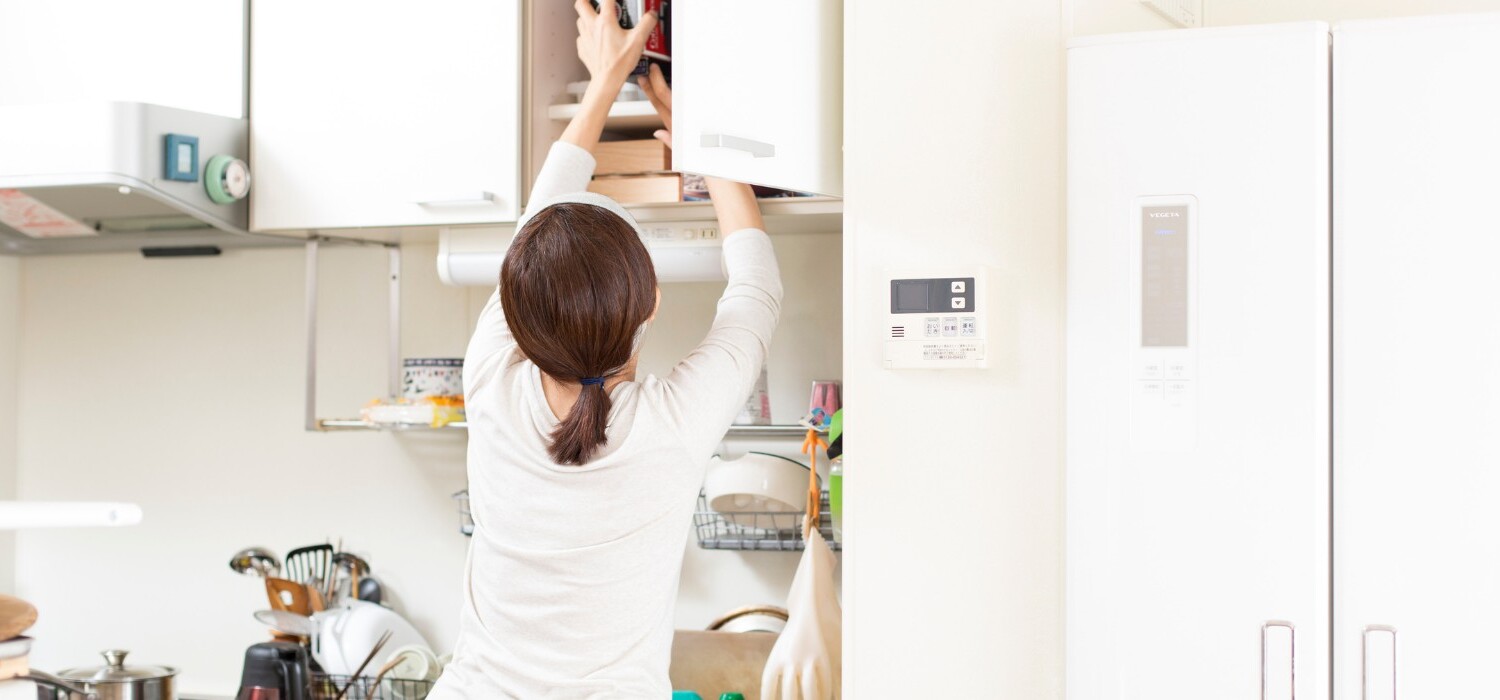Kitchen and bathroom components are two of the most important aspects of a remodel. It’s crucial to choose the right components for your specific project, as they will play a major role in the end result.
It’s fascinating how often we get asked questions from clients about the difference between certain fixtures in the kitchen and bathroom. So we figure, why not get to the bottom of it?
In this blog post, we will discuss the differences between kitchen and bathroom components. We’ll cover everything from faucets to tile so that you can make an informed decision about your remodel. Let’s get started!
What Is the Difference Between Kitchen and Bathroom Faucets?
The difference between kitchen and bathroom faucets can largely come down to their size, their purpose, and the materials often used to make them.

The most glaring difference here is kitchen faucets are typically larger than bathroom faucets. They also have a more curved design in most models, as they are meant to be seen and used from all angles. This allows for a kitchen faucet to be more of a statement piece that flows well with the kitchen aesthetic. Also, the purpose of a kitchen faucet is more than just to wash your hands, you could also be cleaning dishes daily which makes the larger design much more functionally appropriate.
In addition, kitchen faucets are typically made of brass or stainless steel, while bathroom faucets are often made of chrome. It’s not uncommon for a kitchen faucet to be made of chrome but the kitchen is an area where homeowner generally chooses to expand their options and show more of their personality.
A feature that kitchen faucets have that bathroom faucets do not is the sprayer functionality. This can be a major selling point for some homeowners, as it allows them to easily clean dishes or vegetables. Another common difference, kitchen faucets typically come with a warranty that is much longer than bathroom faucet warranties, due to the type of use they get daily.
Can You Use a Kitchen Faucet in A Bathroom?
In short, yes. You can use a kitchen faucet in a bathroom as long as it is the correct size.
While kitchen faucets are larger than bathroom faucets, there are still many models that would fit comfortably in a smaller space. Just be sure to double-check the measurements before making your purchase!
What Is the Difference Between Kitchen and Bathroom Sinks?
The difference between kitchen and bathroom sinks is largely based on their size.
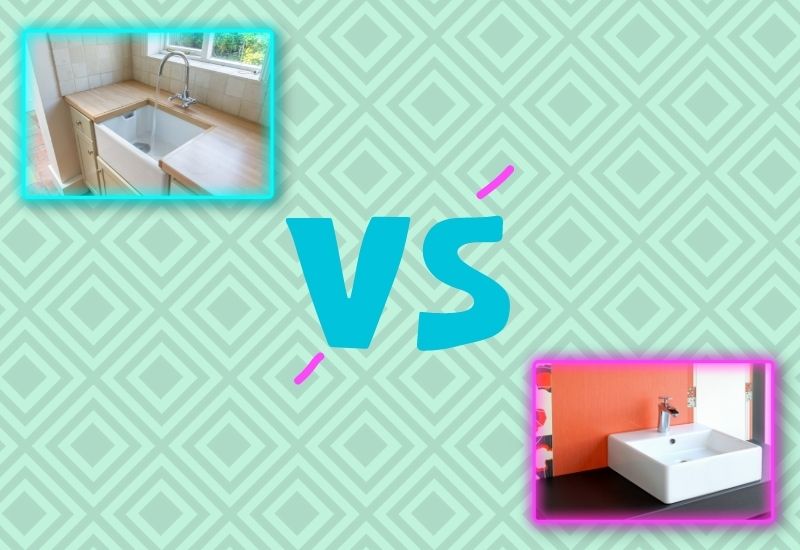
Kitchen sinks are typically larger than bathroom sinks, as they are meant to accommodate more dishes or pots and pans. In addition, kitchen sinks usually have a deeper basin than bathroom sinks, which again allows for more space to wash dishes.
One of the biggest differences between kitchen and bathroom sinks, however, is kitchen sinks are often installed as a standalone piece in the kitchen, while bathroom sinks are typically installed as part of the vanity. This means that kitchen sinks usually come with cabinets and countertops attached, while bathroom sinks do not.
Again, the purpose of the sink in each room is a major factor in why they are so different. While we’ve already mentioned the purpose of kitchen sinks (washing dishes, pots, and pans), the bathroom sink is generally reserved for washing your hands, brushing your teeth, and shaving. There usually isn’t a big draw to having a large bathroom sink, especially since these rooms are not normally very large, to begin with.
Lastly, kitchen sinks are often made of stainless steel or cast iron, while bathroom sinks are often made of porcelain or ceramic. This is because kitchen sinks are often exposed to more water and harsher chemicals than bathroom sinks, so they need to be made of more durable material.
Can You Use a Kitchen Sink in The Bathroom?
Yes, you can use a kitchen sink in the bathroom as long as it is the correct size.
Of course, you need to check the measurements, especially since most kitchen sinks have a deeper basin than what you normally use in a bathroom.
What Is the Difference Between Kitchen and Bathroom Cabinets?
The difference between kitchen cabinets and bathroom cabinets is largely based on their size and the materials used to make them.
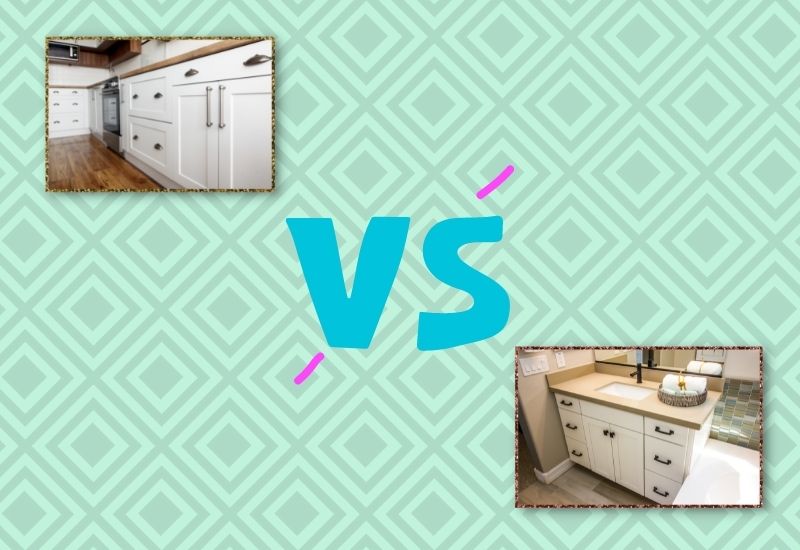
Kitchen cabinets are typically larger than bathroom cabinets, as they are meant to accommodate more dishes or pots and pans. In addition, the materials used for many kitchen cabinets offer more durability and stability than their bathroom counterparts, if the homeowner is willing to pay for the upgrade.
But don’t rule out the durability of a solid bathroom cabinet! Any good builder knows that a bathroom is exposed to seem pretty harsh conditions. With the limited amount of square footage in a bathroom, your cabinets get a daily dose of water, steam, and all-around humidity from regular shower use. So if you’re looking for a kitchen-quality cabinet that will last in your bathroom, be sure to go with a solid wood cabinet or one made of moisture-resistant material.
One of the biggest differences between kitchen and bathroom cabinets, however, is kitchen cabinets are often installed as a standalone piece in the kitchen, while bathroom cabinets are typically installed as part of the vanity.
Kitchen cabinet sizes also vary, while bathroom cabinet sizes are typically more uniform. This is because kitchen cabinets need to be able to store a lot of different items, while bathroom cabinets only need to store toiletries and other small objects. The benefit of kitchen cabinets is having the option to get deep and tall varieties, whereas similar customization for bathroom cabinets is a specially made item.
Can You Use a Kitchen Cabinet in The Bathroom?
Yes, you can use a kitchen cabinet in the bathroom. Just know that some modifications will most likely have to be made.
For instance, kitchen cabinets are often deeper than bathroom cabinets. So, if you’re using a kitchen cabinet in the bathroom, you’ll need to cut down the depth of the cabinet so that it doesn’t stick out too far from the wall.
Additionally, kitchen cabinets typically have a crown or other type of decorative molding around the top edge. If you’re using a kitchen cabinet in the bathroom, you’ll need to remove this molding so that it doesn’t get wet.
Finally, there will need to be some plumbing access given to the kitchen cabinet that it does not already have.
What Is the Difference Between Kitchen and Bathroom Paint?
Kitchen and bathroom paint are more or less the same. There is virtually no difference between each other. However, these two paints are formulated differently than other kinds of paints, to avoid varying degrees of moisture and oil.
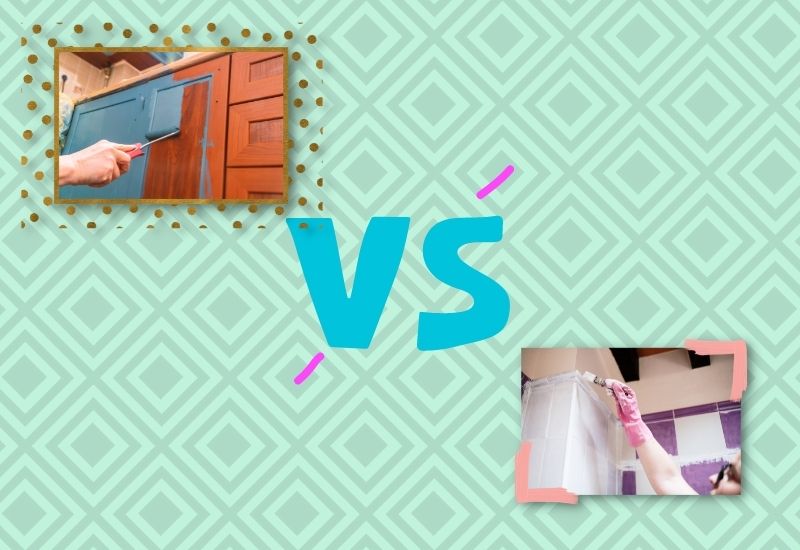
Kitchen paint is regularly exposed to moisture, heat, and grease. Just as bathroom paint is in constant contact with humidity and possible mildew.
While these paints for these specific rooms are mostly the same, there is a subtle difference in terms of their recommended finish. Kitchen paint is often finished with a semi-gloss or high-gloss finish to make it easier to clean, while bathroom paint is usually finished with a satin or matte finish.
Can You Use Kitchen Paint in A Bathroom?
Yes, kitchen paint can be used in a bathroom.
Just be aware that there are products lines where the recommended room for the paint is strictly for kitchen areas or bathroom-type environments.
If kitchen paint is used in a bathroom, it’s important to use paint that has been specifically formulated for a bathroom-like environment. This will ensure that the paint can withstand the high levels of humidity and moisture found in these spaces.
What Is the Difference Between Kitchen and Bathroom Tile?
Tile is tile, right?
Not exactly.
Kitchen and bathroom tiles are not exactly the same, for reasons including their size and the type of material that makes up the tile.
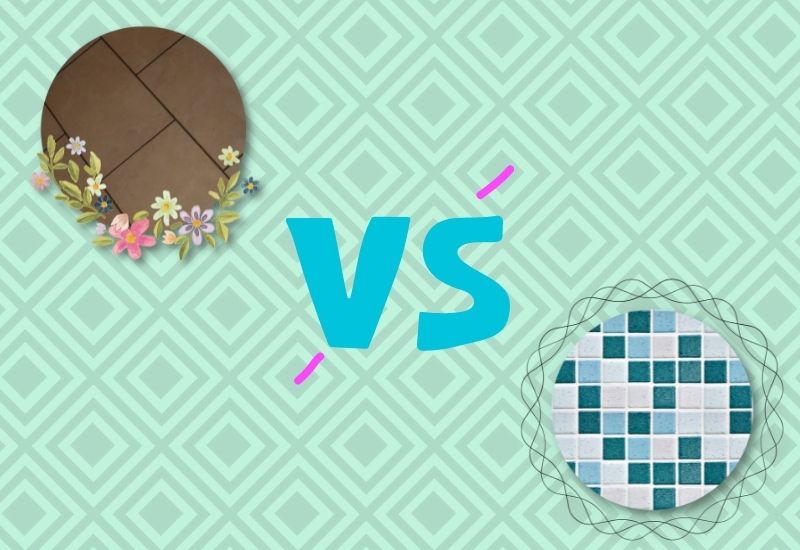
First of all, kitchen tiles are often larger than bathroom tiles. This is because kitchen tiles are meant to be seen and not necessarily touched as much as bathroom tiles. While you can use larger tiles in your bathroom, which can really turn some heads, generally smaller tiles have had more popularity in the past for bathroom flooring and walls. However, it’s clear that in the last 10 years or so, bigger tiles in the bathroom have gained more popularity among homeowners.
Another difference between kitchen and bathroom tiles is the material that makes up the tile. Kitchen tiles are often made of ceramic, while bathroom tiles can be made of ceramic, porcelain, stone, or glass.
This difference in materials is due to the fact that kitchen tiles are more likely to be a high-traffic area; definitely more so than the bathroom. A high traffic area needs to have a flooring material that can withstand a lot of wear and tear.
For bathroom tiles, the importance is centered around picking a tile that is water-resistant and non-slippery. Accidents happen all the time in the bathroom when water and tile are involved. Perhaps the best material used in a bathroom is mosaic tiles. Mosaic tiles are non-porous, which means that they do not absorb water and, as a result, they are water-resistant.
While they can cost a little bit extra than other options, the efficiency of mosaic tiles can’t be ignored.
Can You Use Kitchen Tile in A Bathroom?
Yes, kitchen tile can be used in a bathroom.
Just be aware that kitchen tiles are not always the best choice for a bathroom.
The most important thing to consider when using kitchen tiles in a bathroom is whether or not the tile is water-resistant. Kitchen tiles are not typically as water-resistant as bathroom tiles. When in doubt, check the box before purchasing to see what your product offers in the form of water resistance.
Conclusion
Kitchen and bathroom components are not exactly the same or even interchangeable. While you can get away with using a fixture from a kitchen in a bathroom, it’s not always the best idea. Depending on the fixture or component you want to use, you could be in for some additional expenses to custom fit the product you desire to use.
But, it’s your kitchen and bathroom. You need to love it above all else. So I say go for it! If you run into any trouble, reach out to us and we may be able to help.

